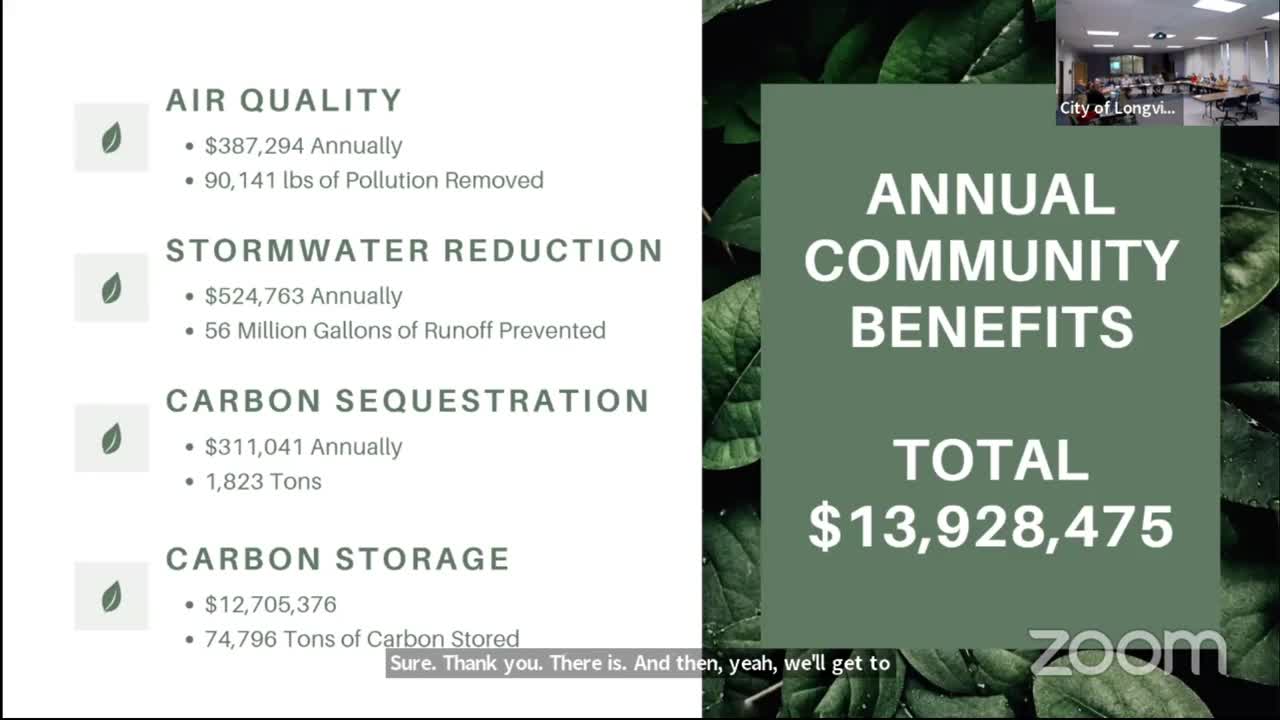Urban forest study reveals millions in annual community benefits
October 17, 2024 | Longview City, Cowlitz County, Washington
This article was created by AI summarizing key points discussed. AI makes mistakes, so for full details and context, please refer to the video of the full meeting. Please report any errors so we can fix them. Report an error »

During a recent government meeting, officials discussed the significant annual community benefits provided by urban trees, highlighting a valuation of nearly $14 million for the city's urban forest. This figure encompasses various environmental advantages, including air quality improvement, stormwater reduction, carbon sequestration, and carbon storage.
The meeting revealed that the urban forest contributes approximately £90,000 worth of pollution removal each year, prevents 56 million gallons of stormwater runoff, and sequesters nearly 2,000 tons of carbon annually. However, there was some confusion regarding the definitions of carbon sequestration and carbon storage, prompting officials to commit to clarifying these terms in future communications.
Officials noted that the newly acquired data on stormwater reduction and carbon benefits could enhance the city’s eligibility for grants and funding opportunities. The Department of Ecology recognizes urban forestry as a best management practice for stormwater management, which allows for the allocation of stormwater funds to support tree-related initiatives.
The discussion also touched on the potential for carbon credits in drier, more polluted communities, where businesses can partner with local governments to plant trees and receive credits in return. This partnership model could serve as a form of environmental mitigation, benefiting both the community and the businesses involved.
In addition to environmental impacts, the meeting highlighted individual benefits of urban trees, including an increase in property values by up to 15% and a reduction in energy costs for heating and cooling by 7%. Studies have also shown that proximity to trees can enhance health outcomes, with patients recovering faster in hospital rooms with views of trees.
Overall, the meeting underscored the multifaceted benefits of urban forestry, emphasizing its role in enhancing community well-being, environmental health, and economic value.
The meeting revealed that the urban forest contributes approximately £90,000 worth of pollution removal each year, prevents 56 million gallons of stormwater runoff, and sequesters nearly 2,000 tons of carbon annually. However, there was some confusion regarding the definitions of carbon sequestration and carbon storage, prompting officials to commit to clarifying these terms in future communications.
Officials noted that the newly acquired data on stormwater reduction and carbon benefits could enhance the city’s eligibility for grants and funding opportunities. The Department of Ecology recognizes urban forestry as a best management practice for stormwater management, which allows for the allocation of stormwater funds to support tree-related initiatives.
The discussion also touched on the potential for carbon credits in drier, more polluted communities, where businesses can partner with local governments to plant trees and receive credits in return. This partnership model could serve as a form of environmental mitigation, benefiting both the community and the businesses involved.
In addition to environmental impacts, the meeting highlighted individual benefits of urban trees, including an increase in property values by up to 15% and a reduction in energy costs for heating and cooling by 7%. Studies have also shown that proximity to trees can enhance health outcomes, with patients recovering faster in hospital rooms with views of trees.
Overall, the meeting underscored the multifaceted benefits of urban forestry, emphasizing its role in enhancing community well-being, environmental health, and economic value.
View full meeting
This article is based on a recent meeting—watch the full video and explore the complete transcript for deeper insights into the discussion.
View full meeting
